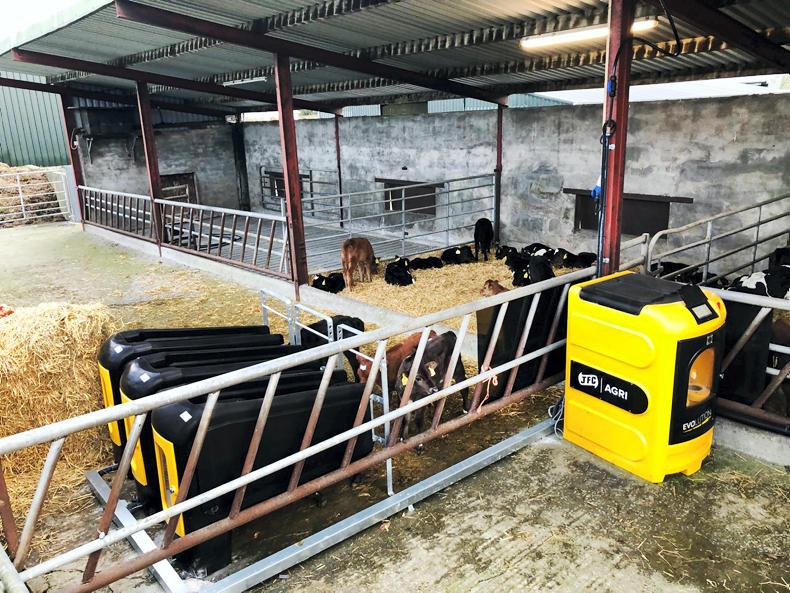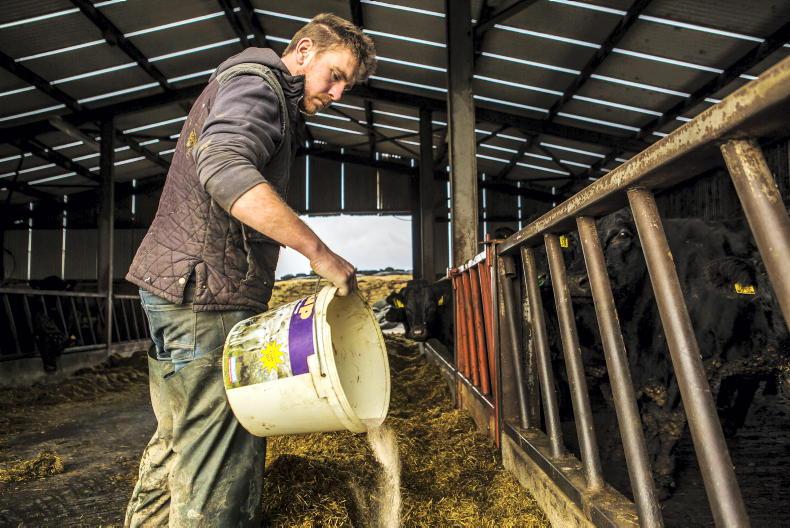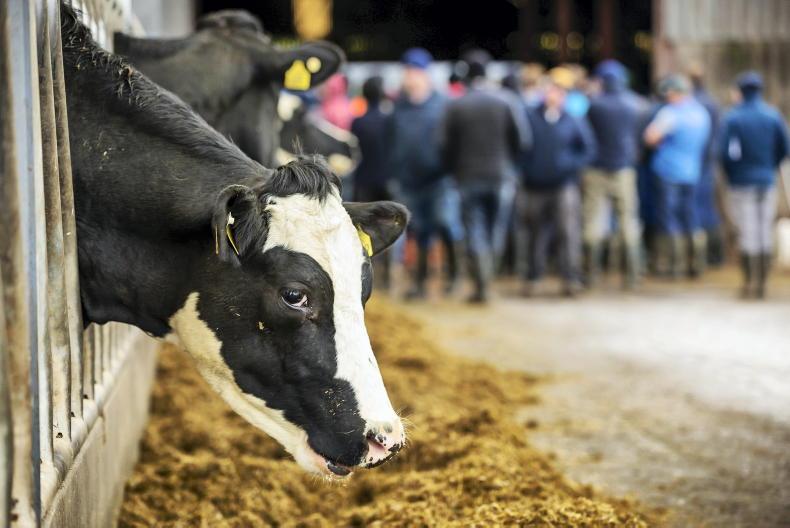The Ploughing Championships marked the launch of JFC’s latest innovation, the Evolution Calf-Feeder.
The feeder has been three years in development according to John Concannon, chair and managing director of the JFC Group who are based in Tuam, Co Galway.
“It’s a good-news story for Tuam and a major technological leap for an Irish firm to be manufacturing an automated calf feeder as sophisticated, yet as easy for one person to operate as this one,” John explains.
The feeder has the capacity to feed 140 calves, according to JFC, with four different feeding stations working with the hopper system.
The feeder has the capacity to feed 140 calves, according to JFC with four different feeding stations working with the hopper system
These four stalls can be put into four separate pens to cater for different groups of stock. The individual feeding stations can be located up to seven metres away from the hopper offering a high level of flexibility for the layout of the calf shed.
The main unit is 0.9m long, 0.74m wide and 1.26m high and weighs 132kg, while the individual feeding stations are 1.44m long, 0.5m wide and 1m high and each weigh 46kg.

One of the key differences for this system is that it contains a dual hopper within the one unit. “Dual-hoppers allow for two different types of milk replacer to be used. This means that a farmer can use a high-protein milk for young heifers to drive weight gain allowing them to be weaned, and as a result, bred as quickly as possible. A more cost-efficient milk, specific for male calves destined for the beef herd can then also be used,” added Damian Concannon, a member of the research and design team at JFC.
Versatile
The system has been designed so that hopper one will provide milk replacer for feeding stations one and three while hopper two will feed into stations two and four.
However, each calf can also be targeted when it comes to the level of milk replacer that they will receive.
Each hopper has the capacity for approximately 30kg of milk replacer, giving a combined capacity of 60kg. The system is self-cleaning, at 12-hour intervals.
“The control unit has a computer interface which reads the calf’s tag and mixes the milk powder at the correct temperature.
"It is connected to the feed stations where the calves drink the amount allocated to each of them and then move away to allow the others to do likewise,” explains Damian.
The ear tags have been developed by fellow Galway natives, Cormac Tagging and are radio frequency identification (RFID) tags.
The system will alert the farmer if a calf does not drink their allocated amount, highlighting that they may be sick and need further attention. 
There is the possibility of selecting one of eight different feed curve options which is linked to the calf’s ear tag to allow each calf to be individually targeted.
“If the farmer notices that one of their calves is not thriving as well as the others they can programme the feeder to target an increase in the amount of milk for that animal. It is as simple as putting that calf on a different feed curve which will allow the animal to get more milk so that it can catch up with the rest of the calves,” according to Damian.

JFC Evolution feeder.
As labour becomes more difficult to source on farms, more and more farmers will move towards an automatic calf feeding system. It may also provide a viable option for those farmers who purchase and rear calves every year, especially for part time farmers.
The total cost of the Evolution Calf Feeder and four feeding stations comes to €13,500, excluding VAT.
“Farming is moving down the road of automation and we have to be able to move with it,” according to Damian.
“Flexibility for farmers was one of our key considerations and that it is easy to use. We wanted it to be as easy for farmers to use as their mobile phone.
“Farmers can often be afraid of automation, or reluctant to change the level of feeding that calves will get but this gives them that option.

“We want the farmer to be comfortable and during what can be a very strenuous calving period for many farms with compact calving this helps to take the pressure,” according to Damian.
The Ploughing Championships marked the launch of JFC’s latest innovation, the Evolution Calf-Feeder.
The feeder has been three years in development according to John Concannon, chair and managing director of the JFC Group who are based in Tuam, Co Galway.
“It’s a good-news story for Tuam and a major technological leap for an Irish firm to be manufacturing an automated calf feeder as sophisticated, yet as easy for one person to operate as this one,” John explains.
The feeder has the capacity to feed 140 calves, according to JFC, with four different feeding stations working with the hopper system.
The feeder has the capacity to feed 140 calves, according to JFC with four different feeding stations working with the hopper system
These four stalls can be put into four separate pens to cater for different groups of stock. The individual feeding stations can be located up to seven metres away from the hopper offering a high level of flexibility for the layout of the calf shed.
The main unit is 0.9m long, 0.74m wide and 1.26m high and weighs 132kg, while the individual feeding stations are 1.44m long, 0.5m wide and 1m high and each weigh 46kg.

One of the key differences for this system is that it contains a dual hopper within the one unit. “Dual-hoppers allow for two different types of milk replacer to be used. This means that a farmer can use a high-protein milk for young heifers to drive weight gain allowing them to be weaned, and as a result, bred as quickly as possible. A more cost-efficient milk, specific for male calves destined for the beef herd can then also be used,” added Damian Concannon, a member of the research and design team at JFC.
Versatile
The system has been designed so that hopper one will provide milk replacer for feeding stations one and three while hopper two will feed into stations two and four.
However, each calf can also be targeted when it comes to the level of milk replacer that they will receive.
Each hopper has the capacity for approximately 30kg of milk replacer, giving a combined capacity of 60kg. The system is self-cleaning, at 12-hour intervals.
“The control unit has a computer interface which reads the calf’s tag and mixes the milk powder at the correct temperature.
"It is connected to the feed stations where the calves drink the amount allocated to each of them and then move away to allow the others to do likewise,” explains Damian.
The ear tags have been developed by fellow Galway natives, Cormac Tagging and are radio frequency identification (RFID) tags.
The system will alert the farmer if a calf does not drink their allocated amount, highlighting that they may be sick and need further attention. 
There is the possibility of selecting one of eight different feed curve options which is linked to the calf’s ear tag to allow each calf to be individually targeted.
“If the farmer notices that one of their calves is not thriving as well as the others they can programme the feeder to target an increase in the amount of milk for that animal. It is as simple as putting that calf on a different feed curve which will allow the animal to get more milk so that it can catch up with the rest of the calves,” according to Damian.

JFC Evolution feeder.
As labour becomes more difficult to source on farms, more and more farmers will move towards an automatic calf feeding system. It may also provide a viable option for those farmers who purchase and rear calves every year, especially for part time farmers.
The total cost of the Evolution Calf Feeder and four feeding stations comes to €13,500, excluding VAT.
“Farming is moving down the road of automation and we have to be able to move with it,” according to Damian.
“Flexibility for farmers was one of our key considerations and that it is easy to use. We wanted it to be as easy for farmers to use as their mobile phone.
“Farmers can often be afraid of automation, or reluctant to change the level of feeding that calves will get but this gives them that option.

“We want the farmer to be comfortable and during what can be a very strenuous calving period for many farms with compact calving this helps to take the pressure,” according to Damian.



















SHARING OPTIONS